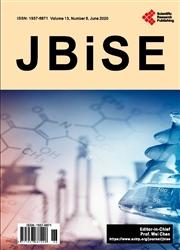Numerical Investigation of Flexural Bending in Biaxial Braided Structures for Flexor Tendon Repair
引用次数: 1
Abstract
Flexor tendon repair has conventionally been done by suturing techniques. However, in recent times, there have been attempts of using fibrous braided structures for the repair of ruptured tendons. In this regard, the numerical analysis of the flexural stiffness of a braided structure under bending moments is vital for understanding its capabilities in the repair of flexor tendons. In this paper, the bending deflection, curvature, contact stresses and flexural bending stiffness in the braided structure due to bending moments are simulated using Finite Element (FE) techniques. Three dimensional geometry and FE models of five sets of biaxial braided structures were developed using a python programming script. The FE models of the hybrid biaxial braids were imported into ABAQUS (v17) for post-processing and analysis. It was established that the braided fabric with largest braid angle, θ = 52.5˚ had the highest flexural deflection while the lowest deflection was seen in the results of the braided structure with the least braid angle, θ = 38.5˚. The results in this study also portrayed that the curvature in biaxial braids will increase with a decrease in the angle between the braided yarns. This was also consistent with the change of bending angle of the biaxial structures under a bending moment. The deformation of the structures increased with increase in the braid angles. This implies that the flexural bending stiffness decreased with increase in braid angle. The stress limits during bending of the braided structures were established to be within the range that could be handled by flexor tendons during finger bending.屈肌腱修复中双轴编织结构弯曲弯曲的数值研究
屈肌腱的修复通常是通过缝合技术来完成的。然而,近年来,已经尝试使用纤维编织结构来修复断裂的肌腱。在这方面,对编织结构在弯矩作用下的弯曲刚度进行数值分析对于了解其在屈肌腱修复中的能力至关重要。本文利用有限元技术模拟了编织结构由于弯矩引起的弯曲挠度、曲率、接触应力和弯曲弯曲刚度。使用python编程脚本开发了五组双轴编织结构的三维几何模型和有限元模型。将混合双轴编织物的有限元模型导入ABAQUS(v17)中进行后处理和分析。研究表明,编织角度最大的编织物θ=52.5˚具有最高的弯曲挠度,而编织角度最小的编织结构θ=38.5˚的弯曲挠度最低。本研究的结果还表明,双轴编织物的曲率将随着编织纱线之间角度的减小而增加。这也与双轴结构在弯矩作用下弯曲角度的变化相一致。结构的变形随着编织角度的增加而增加。这意味着弯曲弯曲刚度随着编织角度的增加而降低。编织结构弯曲过程中的应力极限被确定在手指弯曲过程中屈肌腱可以处理的范围内。
本文章由计算机程序翻译,如有差异,请以英文原文为准。
求助全文
约1分钟内获得全文
求助全文

 求助内容:
求助内容: 应助结果提醒方式:
应助结果提醒方式:


